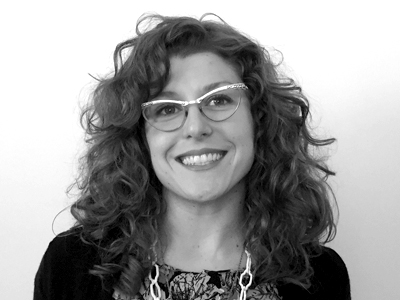
Adriane Dalton: Begin by telling our readers where you’re from, where you currently reside, and a bit about your educational background.
Liv Blåvarp: I live and work in the rural area of south-east Norway, where my studios have been located within the municipality of Østre Toten; I moved back there from Oslo in 1986. Since 2005, I’ve shared workspace with my partner, Tore Gimle, in our home on the outskirts of the small village of Lena. We’re surrounded by a soft, affluent landscape dominated by the great lake Mjøsa, right in the midst of rich agriculture. This is also where I was born and raised.
In 1979 I went to college in Oslo; at the time it was called State College of Art and Design. Back then, the college provided a classical education of drawing and sculpting along with the activities in the department studios where we had classes in various metal techniques. We also spent a great deal of time crafting our own ideas as the college kept the doors open ’til late night and Saturdays as well. In 1983 I was among six students who graduated from the department of metalwork. We later formed the group TRIKK, a companionship that lasted for some years, giving us an important start as artists. However, right after my graduation in Oslo, I applied as a student at the Royal College of Art in London. Being accepted, I spent one year in this famous place before rejoining TRIKK in 1984. I stayed in the group until 1986, when I decided to move back home due to the need for better studio facilities.
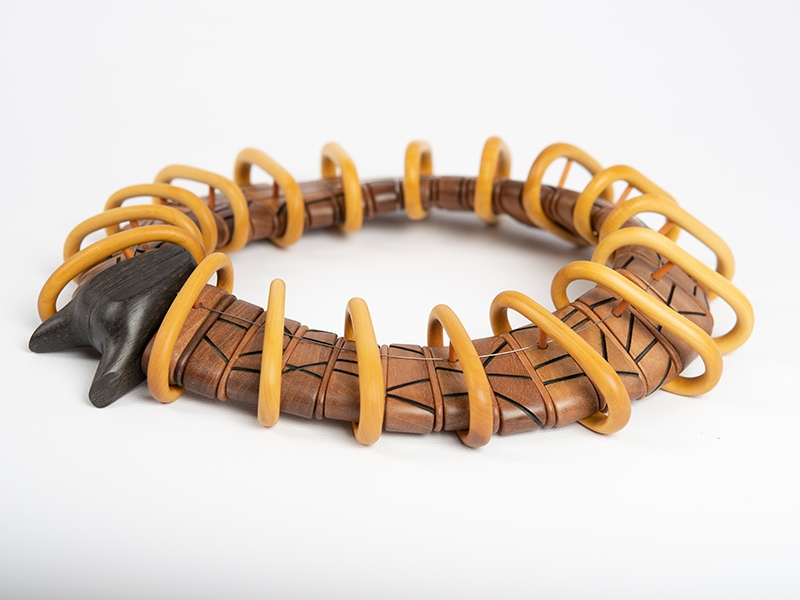
How did you arrive at jewelry, and necklaces in particular, as your predominant mode of expression?
Liv Blåvarp: To be honest, jewelry was a coincidental thing for me. I wanted to do graphics, drawing in particular, but at the time I went into college my skills in that direction were insufficient. I was given the opportunity to go forward in the department of metalwork. It didn’t take me long to become absorbed and passionate.
It was difficult in the beginning, given the fact that I had no technical background to support the crafting I wanted to perform. Toward the end of my studies in Oslo, I arrived at a point of needing a platform for completing my diploma. This was a crucial situation for choosing direction, and also a need to find a unique personal expression regarding my future work.
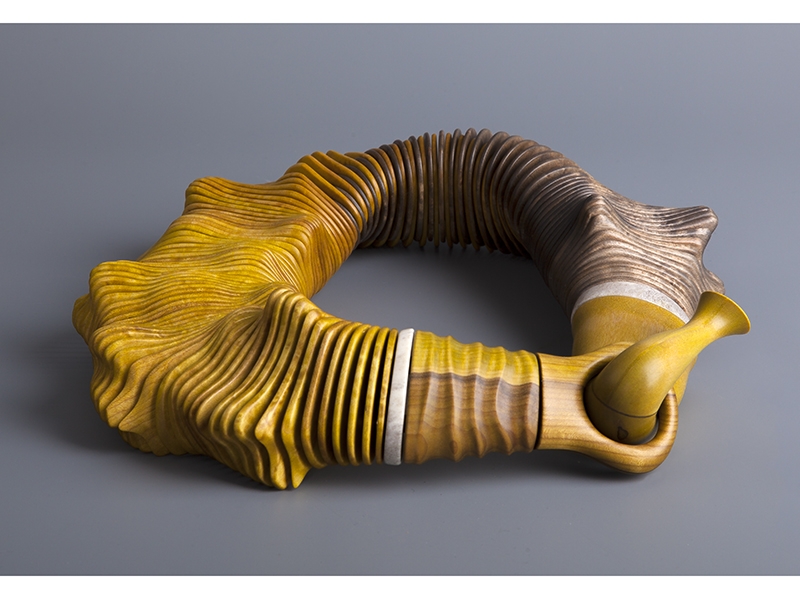
This was when I discovered the possibilities of using wood in jewelry. The fascination with necklaces sprung from this, as the size of a necklace fits better for such materials. Necklaces are dominant human ornaments; the nature of this jewelry embraces the body in a powerful way, making a piece not only a comment but also a strong statement for the wearer as well as for the maker. I really love the aspect of sculpting as I create the necklaces; it fits my nature and flair for volumes. I believe sculpting is my stronger side, and at this point in time I’ve investigated this potential for the last 30 years. I find it stimulating to work on pieces of some size; it offers me the opportunity to express my love for organic structures, and satisfies not only the eye but gives pleasure to the hands as we touch and handle the jewelry.
Movement is a visual presence in your work and also critical to functionality. Can you speak to this relationship and how you marry both form and function in your designs?
Liv Blåvarp: First I would like to point out that pieces like mine will turn out to be unwearable unless they feature a high level of movability.
I want my pieces to be like living creations well balanced to the wearer’s need for function. I aim to shape the pieces in a manner that allows the wearer to change the position of the necklace and, in this way, the expression will also change to the liking of its owner. The pieces should move with the body, and in the process of making I need to keep a frequent eye on this matter. This comes about by fitting the piece on a dummy, adjusting size, and, many times, adding parts so that the form moves freely around the shoulders. By using a dummy, I can judge how daringly and boldly the work can be shaped and still be a soft and flexing jewel. The movement of my pieces is significant not only for wearability, but also a deep and rooted nature of my designs. By focusing on this aspect, one touches the core of my art. Sketches are in most cases the starting point of every process. Essentially, the context of my work is a relationship between the autonomism of the work and its powerful potential as human adornment.
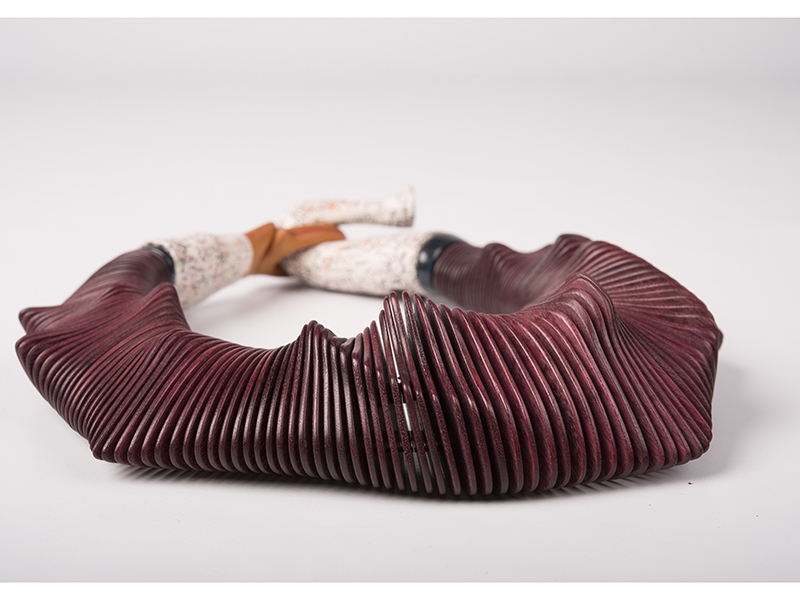
I haven’t had the pleasure of encountering your work firsthand, but from what I’ve read your necklaces are surprisingly lightweight in spite of their volume. What have been the challenges and discoveries in your process that have allowed you to balance wearability and visual impact?
Liv Blåvarp: Preparing for my first solo show in 1988, I realized that a change of course was crucial for my future in the field. The necklaces I made back then were solid pieces with no flexibility. They were uncomfortable to wear and awkward to put on. During the period of preparing for this show, which took place in Kunstnerforbundet, in Oslo, sketch work brought me to ideas based on structural forms made by assembling small parts. I completed a small number of such necklaces for this occasion and thereafter a great many years followed in which I experimented and tested a lot of ideas of this kind.
Changing the work from solid pieces to flexible structures was a true booster for my work and brought it all into a vital development. This alteration of methods gave me what was lacking before: wearability and, as a bonus, the artistic excitement of the building and constructing. The structural work has a visual flow that I really enjoy.
The weight of the necklaces differs according to the materials. Some are heavy, others are very light. I believe the flexibility is the ruling feature.

Part of what’s striking about your work is your use of color—both the natural tones in the wood as well as your application of paints and stains. How do you approach color in your compositions, and how do you decide to apply color versus using the natural tone of the wood?
Liv Blåvarp: I can’t always explain everything I do and all the moves I make in a process. Choices are a gut feeling and a matter of intuition. Often things come about by impulse. Our mind has a million ways of steering us. We’re emotional beings, enjoying the multiple images of the world coming to us by seeing, hearing, or touching. There are periods of favoring this or that. When it comes to color, I try to figure out a palette when sketching, though I know it will change along the line. Many things will be altered from sketching until the work is finished. It’s impossible to have an absolute and firm idea of how to apply colors before the pieces are ready regarding form. One needs to interpret the nature of it before enforcing it by colors, either for contrast, or beauty by disharmony. There are many daring ways of using colors, and daring ways are where I want to go. There’s no future without risk.
Sometimes I have a beautiful material that deserves to expose itself just the way it is. If so, I try to find contrasting combinations of other nice sorts of materials and leave it that way. Then again, occasionally, I won’t hesitate to incorporate painted parts or sections in structures based on natural tones. In art, we do a lot of unexpected things and there are no set arrangements. I suppose it’s all about the pursuit of some basic qualities such as radiation of light and contrasts. One needs to find the key to vibrant expressions by trying and failing. I often paint and repaint many times to be satisfied.

Many of your titles refer to animals or nature. In examples such as Octopus, the reference is quite clear, but works such as Voice of the Forest are much more subtle expressions. What’s your inspiration-gathering process like? How do you conceive of these forms, and how do you set about translating them into the works?
Liv Blåvarp: My expressions always revolve in themes of nature, and the driving force comes mainly from the work itself. There have been periods of animals and birds, geometry in organic growth, at times it has to do with water. The necklace Voice of the Forest belongs to a small series of work based on topography. Giving it this title, I saw a terrain in this structure, like the ground under tall trees emphasized by the coloring of greenish yellow and slate gray. When work comes to a certain point, it starts to explain itself, telling me in which direction to go by adding or subtracting. Associations often guide my steps in unpredictable and surprising ways. I really don’t think there’s a straight line from the things I see to the things I make
Better maybe to explain it like this: I file a lot of impressions and bring them out later for consideration. There are a lot of filters. I believe conceiving an idea is an internal phenomenon. It occurs from the work itself and the current will to do things in new ways.

What have you read lately?
Liv Blåvarp: A five-volume novel by Edvard Hoem, telling the story of his ancestors and their emigration to the United States and Canada.
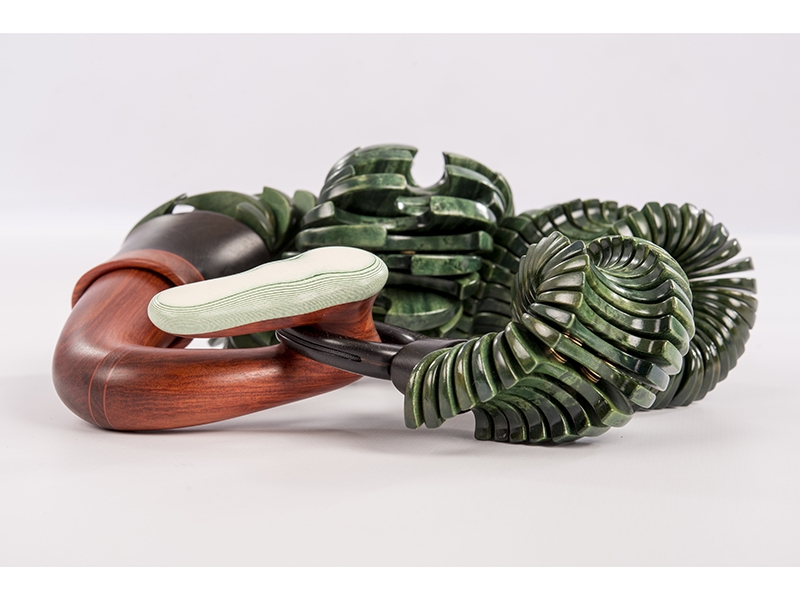
Who are some artists—both in the field of art jewelry and beyond—whose works inspire or move you?
Liv Blåvarp: There are so many brilliant artists worth admiring! In my young days, Caroline Broadhead, from London, was number one to me. She was so extremely innovative and bold in making her nonprecious jewelry. In later years I discovered and liked the German jeweler Bettina Speckner a lot, and also Helen Britton, from Australia. Both of them are wonderful storytellers in their way of dealing with materials. Most of all I love and admire Dorothea Prühl, from Germany. She’s truly unique in the way she unites materials and themes, and admirable also for mastering a great variety of techniques in both wood and metal.
The encounter with Spanish artist Jaume Plensa was a great experience to me. He applies the old techniques of cast iron in his sculptures and I find it so wonderful to recognize the quality of the iron in such a sensitive expression. His work can be seen all over the world in public spaces.
However, there’s no one to me like Tone Vigeland. I’ve regarded her as my mentor from the very beginning. Her presence in the field is beyond compare for everyone in my field and generation. She’s our queen of contemporary jewelry.
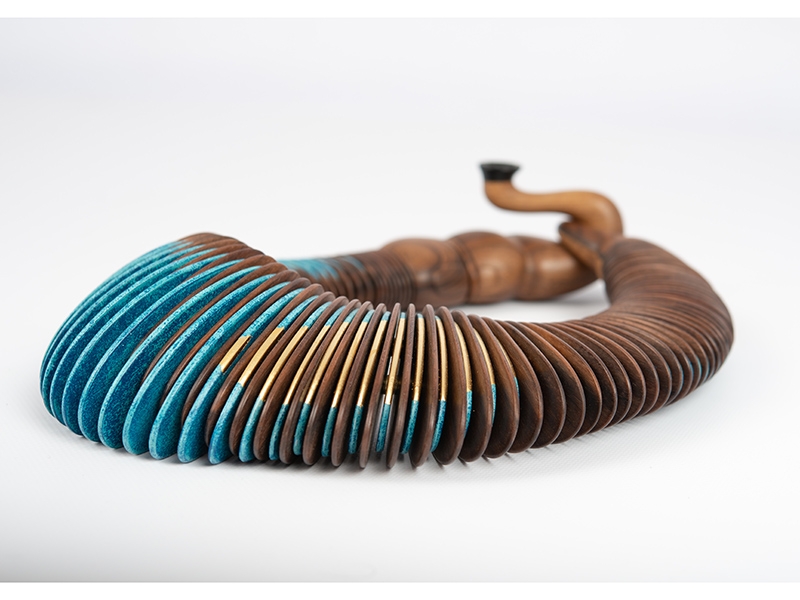
As someone with a lengthy career, what advice do you have for new makers and early career artists?
Liv Blåvarp: Stay close to your heart and stay in the studio.
Thank you.
